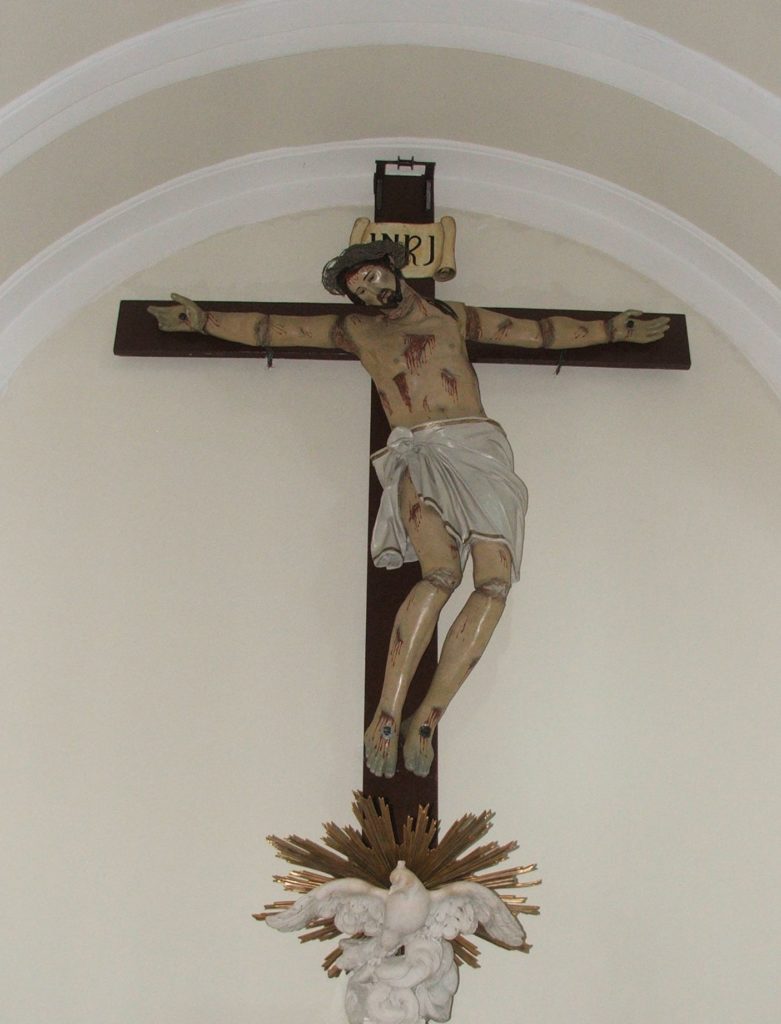Cristo Crocifisso

Chiesa di S. Maria Maggiore
Crocifisso mobile
Cristo crocifisso
Sec. XIX (prima metà)
Cartapesta e gesso dipinto
Ambito irpino

Church of S. Maria Maggiore
Mobile crucifix
Crucified Christ
19th century (first half)
Papier-mache and painted plaster
Irpinia background
L’opera appartiene alla serie dei Crocifissi mobili, noti fin dal Medioevo, che venivano utilizzati durante la liturgia del Triduo Pasquale che prevedeva alcuni riti con l’immagine del Cristo crocifisso e del Cristo deposto. Queste sculture, avendo parti del corpo mobili, fungevano sia da crocifissi che da deposti. In particolare, venivano usati durante il Venerdì Santo per rendere più verosimile la celebrazione del rito della deposizione dalla Croce.
Grottaminarda, fino al terremoto del 1980, aveva anch’essa la sua rappresentazione sacra dei riti pasquali: la macchina scenografica veniva montata nell’area presbiteriale e l’altare maggiore rappresentava il calvario su cui era infissa la croce con il Crocifisso. Durante la lettura della Passione, attraverso lo scioglimento di alcune corde, avveniva la morte di Gesù, che materialmente chinava la testa sul petto.
Alla fine della liturgia, sempre attraverso corde e con l’ausilio di alcune persone, il Cristo veniva calato dalla croce e deposto su di un lettuccio che veniva poi portato a spalle per le vie della cittadina.
Celebre, durante la processione, era anche l’incontro della Vergine Addolorata con il figlio morto, che avveniva nei pressi di Portaurea. I due cortei, uno con il Cristo morto e uno con la Vergine, partivano dalle due chiese principali e si incontravano a Portaurea dove si fondevano in una sola processione.
The work belongs to the series of mobile Crucifixes, known since the Middle Ages, which were used during the liturgy of the Easter Triduum and included some rites with the image of the crucified Christ and the deposed Christ. These sculptures, having mobile body parts, served as both crucifixes and depositions. In particular, they were used during Good Friday to make the celebration of the rite of deposition from the Cross more likely.
Until the earthquake of 1980, Grottaminarda also had its sacred representation of the Easter rites: the scenographic machine was mounted in the presbytery area and the high altar represented the ordeal on which the cross with the Crucifix was fixed. During the reading of the Passion, through the melting of some ropes, the death of Jesus occurred, who materially bowed his head on his chest.
At the end of the liturgy, always through ropes and with the help of some people, Christ was lowered from the cross and placed on a bed which was then carried on the shoulders through the streets of the town.
Famous during the procession was also the meeting of the Virgin of Sorrows with her dead son, which took place near Portaurea. The two processions, one with the dead Christ and one with the Virgin, started from the two main churches and met in Portaurea where they merged in one procession.

